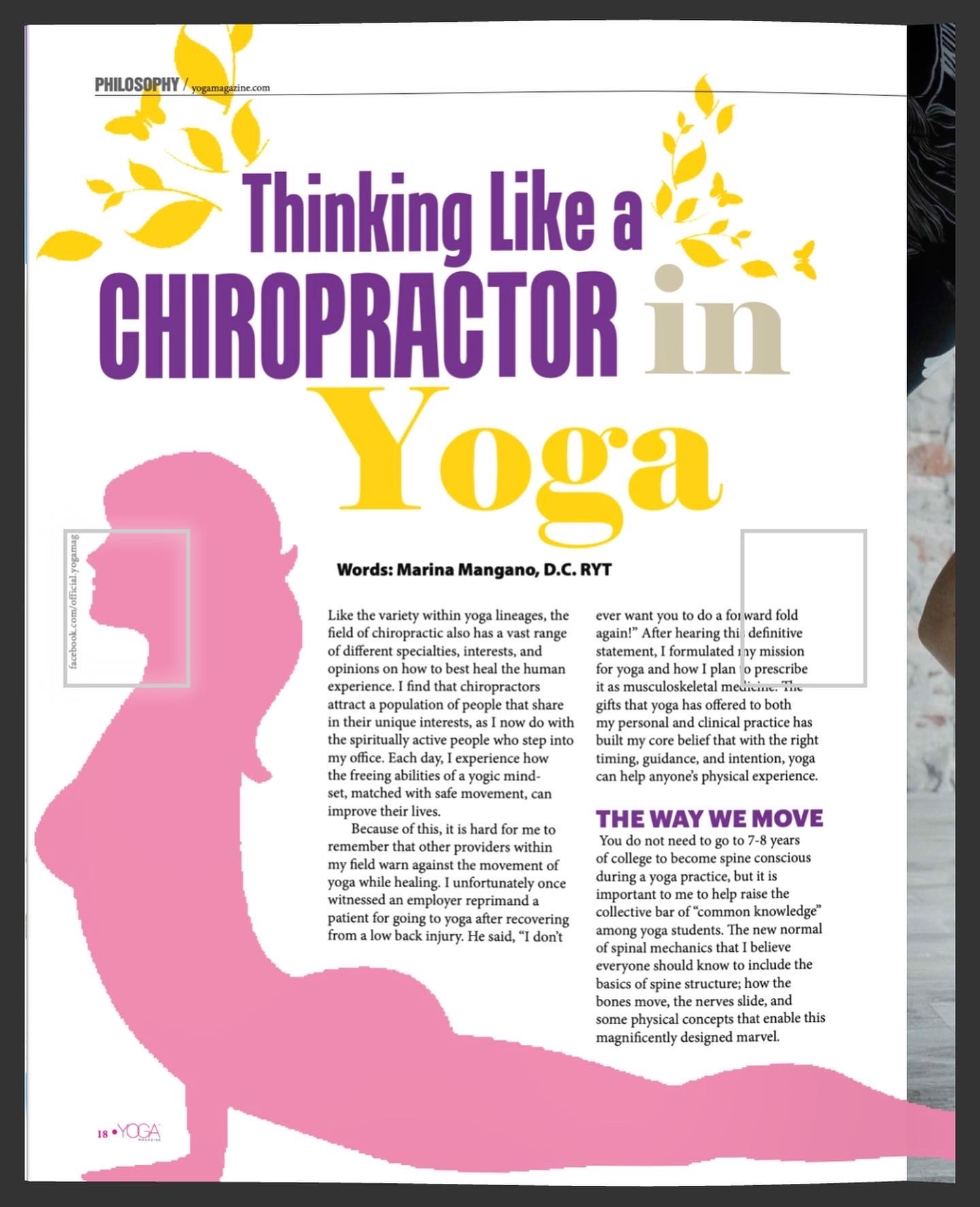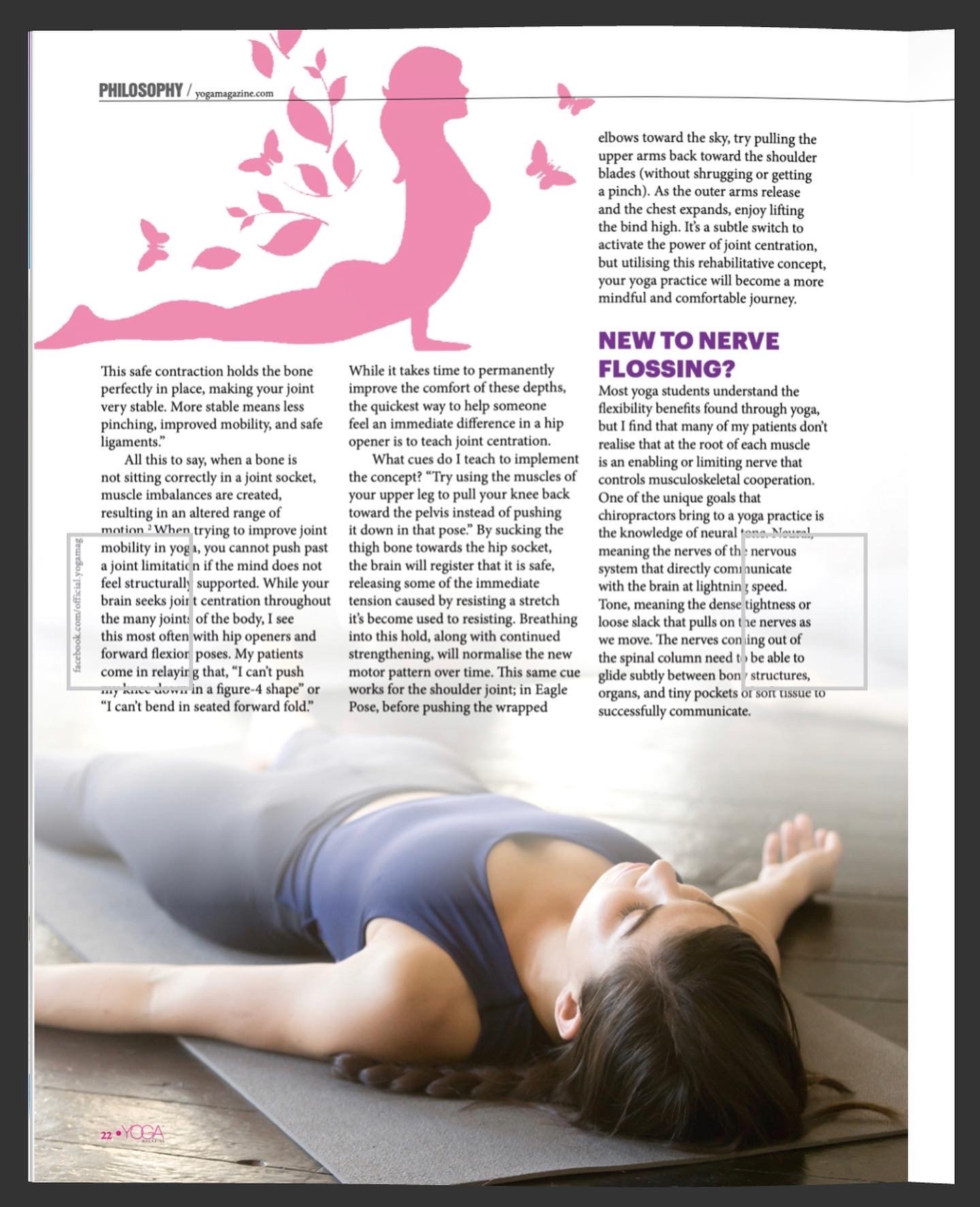Thinking Like a Chiropractor In Yoga
As Published in The Yoga Magazine 11/22
By Marina Mangano, D.C. RYT
Like the variety within yoga lineages, the field of chiropractic is also a vast range of different specialties, interests, and opinions on how to best heal the human experience. I find that chiropractors attract a population of people that share in their unique interests, as I now do with the spiritually active people who step into my office. Each day, I experience how the freeing abilities of a yogic mindset, matched with safe movement, can improve their lives.
Because of this, it is hard for me to remember that other providers within my field warn against the movement of yoga while healing. I unfortunately once witnessed an employer reprimand a patient for going to yoga after a recovering from a low back injury. He said, “I don’t ever want you to do a forward fold again!” After hearing this definitive statement, I formulated my mission for yoga and how I plan to prescribe it as musculoskeletal medicine. The gifts that yoga has offered to both my personal and clinical practice has built my core belief that with the right timing, guidance, and intention, yoga can help anyone’s physical experience.
The Way We Move
You do not need to go to 7-8 years of college to become spine conscious during a yoga practice, but it is important to me to help raise the collective bar of “common knowledge” within yoga students. The new normal of spinal mechanics that I believe everyone should know include the basics of spine structure; how the bones move, the nerves slide, and some physical concepts that enable this magnificently designed marvel.
Spinal Movement 101
I see yoga as anatomy in motion; a flowing symphony of mechanical locking, coordinated unlocking, and electric regulators in between. The main character of the show of course, is the spinal column, the central stack of bones that safely houses the central nervous system and supports life’s movement.
Spinal motion is enabled by five different regions of structurally unique bones. (See Image 1) The cervical, thoracic, lumbar, sacral, and coccygeal spines are each in charge of helping our structure to move in specific ways. For example, the tiny bones of the cervical spine enable the neck to move in a wide range of directions for clear airways, visual fields, and expression. The thoracic spine in comparison, works together with the ribs to house our vital organs and enable breath capacity. It can’t afford to be nimble like the neck! To create motion limitations, each of the vertebral sections are uniquely designed to create natural locks with the bone above or below it.
How does this anatomy apply to yoga? Well knowing that each region has bony locks to prevent you from moving too far will come in handy when the body is sending out signals to back off from a deep stretch. For example, there is a reason that your lumbar spine is not the target location for spinal twists. The base bones found here are built to gently lock when turning, encouraging you to twist instead from the midback or hips. Though they are resistant to twists, the low back locks (called facet joints) allow us to safely shine during side, forward, and backward bending. A yoga teacher who knows the differences between vertebral structures can cue correctly throughout class to help their students reduce strain on the spine and capitalize on the natural advantages built into the body. Look into spinal biomechanics in your own research or watch videos of spinal motion to grasp the relationship of your spine through yoga.
Early Morning Classes, Meet the Intervertebral Discs
The next anatomic gift that I’d like to present, is the understanding of the interverbal discs. Use this knowledge, along with your intuition, to best select the timing of your movement practices each day.
In between each of the vertebra of the spine lives an intervertebral disc (see Image 2). The inside of the disc is made of a gelatinous material, ideal for absorbing the shock of forces that move along the curve of our spine. Due to being non-weight bearing while we sleep, the material within the discs rehydrates each night, recovering from a long day of gravity and behavioral movements.1 This “filling” is why the discs seem to take up more space within the spine each morning, making us stiff until our daily routine kicks in.
I tell patients that suffer from a disc injury or a nerve root irritation that there will be “less room for error” as we move in the morning. But then as motion intensifies throughout the day, gravity again reduces the height of the discs giving us more spinal mobility. Ideally through rehabilitation, we gain endurance to prevent collapsing on the spine throughout the day but until then, timing is very important when selecting which activity to start your day with. I find that forward bending and transitions between poses are the most irritable movements in a sunrise yoga class. Selecting a gentle morning flow, rehab-styled exercises, or a form of easy and upright cardio are all wonderful options to prepare your spine for the strenuous extremes of the day. For those that only have the option of an early exercise, please listen to your body. On a stiff day, take an inch off your deepest expression of each pose and use abdominal breathing to coax the spine awake while you move.
Helping Your Brain Locate Safe Joints
In my recently published book, The Gift of Healing Hands, I discuss a mechanical concept known as joint centration which can benefit every person looking to improve painful postures during organized movement:
“Joint centration is a term that describes the perfect position for a joint to be placed in so that the supporting muscles are evenly centered around the joint and can then fire together in unison when used to move. This safe contraction holds the bone perfectly in place, making your joint very stable. More stable means less pinching, improved mobility, and safe ligaments.”
All this to say, that when a bone is not sitting correctly in a joint socket, muscle imbalances are created, resulting in an altered range of motion.2 When trying to improve joint mobility in yoga, you cannot push past a joint limitation if the mind does not feel structurally supported. While your brain seeks joint centration throughout the many joints of the body, I see this most often with hip openers and forward flexion poses. My patients come in relaying that, “I can’t push my knee down in a figure-4 shape” or “I can’t bend in seated forward fold.” While it takes time to permanently improve the comfort of these depths, the quickest way to help someone feel an immediate difference in a hip opener is to teach joint centration.
What cues do I teach to implement the concept? “Try using the muscles of your upper leg to pull your knee back toward the pelvis instead of pushing it down in that pose.” By sucking the thigh bone towards the hip socket, the brain will register that it is safe, releasing some of the immediate tension caused by resisting a stretch it’s become use to resisting. Breathing into this hold, along with continued strengthening, will normalize the new motor pattern over time. This same cue works for the shoulder joint; in Eagle Pose, before pushing the wrapped elbows toward the sky, try pulling the upper arms back toward the shoulder blades (without shrugging or getting a pinch). As the outer arms release and the chest expands, enjoy lifting the bind high. It’s a subtle switch to active the power of joint centration, but utilizing this rehabilitative concept, your yoga practice will become more mindful and comfortable journey.
New to Nerve Flossing?
Most yoga students understand the flexibility benefits found through yoga, but I find that many of my patients don’t realize that at the root of each muscle is an enabling or limiting nerve that controls musculoskeletal cooperation. One of the unique goals that chiropractors bring to a yoga practice is the knowledge of neural tone. Neural, meaning the nerves of the nervous system that directly communicate with the brain at lightning speed. Tone, meaning the dense tightness or loose slack that pulls on the nerves as we move. The nerves coming out of the spinal column need to be able to glide subtly between bony structures, organs, and tiny pockets of soft tissue to successfully communicate.
Neurodynamics, more commonly called “nerve flossing,” is a rehabilitative approach that targets the nerve tracks and, utilizing repetitive flowing movements, aims to help the nerve restore its normal tone.3 Anyone who has stiffly sat in a seated forward fold knows how much tension can build within the back body. At your largest C shape or fold, the central nervous system has the maximum tension placed on it. In that same posture, by arching your chest and naval forward, gently bending the knees, and pointing the ankles, you create slack on the nervous system of the back body. This S shape reduces the tension and calms the nervous system. Repeatedly flowing between your sitting S and C shape allows the nerves to tug between both anchoring ends, freeing any entrapments in between. Each major nerve path from head to toe has a specific movement that can floss the web of the nervous system, relieving neck tension, shoulder limitations, sciatica, and lower leg weaknesses. I highly recommend finding a chiropractor or physical therapist who prescribes nerve flossing to address areas on your body that are chronically tight. You may find that an underlying issue comes from neural tone more than tight hamstrings alone.
Application & Action
If the concepts and sciences above seem inaccessible to you, as if the information only applies to providers or trained teachers, trust that all students, all minds, and all bodies will benefit from learning how the powerful nervous system lives at the heart of yoga. I invite everyone — regardless of education levels — to read, experiment, breathe, and then move some more. Grasping the mindset of chiropractic within yoga’s art looks a little robotic at first. This technical and safe form of yoga will cement into your movement, becoming second nature and giving you the confidence to practice more relaxed when it’s time. That fluid intuition will guide you to learn more ways in which the spine acts at the antenna of health, a tuning fork for equilibrium that extends far beyond the four corners of your mat.
Sources
De Geer, Christopher. Intervertebral Disk Nutrients and Transport Mechanisms in Relation to Disk Degeneration: A Narrative Literature Review. Journal of Chiropractic Medicine. 2018 Jun; 17(2): 97–105. Web Accessed August 31, 2022.
Stuart McGill, Low Back Disorders (Champaign, IL: Human Kinetics, 2007) Print.
Shacklock, Michael. Clinical Neurodynamics: A New System of Neuromusculoskeletal Treatment. (Butterworth-Heinemann, 2005) Print.
· Image 1. The axial skeleton. Mangano, Marina. The Gift of Healing Hands.
(Bloomington, IN: Balboa Press. 2021) Print.
· Image 2. Intervertebral Segment. Mangano, Marina. The Gift of Healing Hands.
(Bloomington, IN: Balboa Press. 2021) Print.
· Image 3. Amanda Jane at Studio Jane photography. 2019.
· Image 4. Amanda Jane at Studio Jane photography. 2019.





